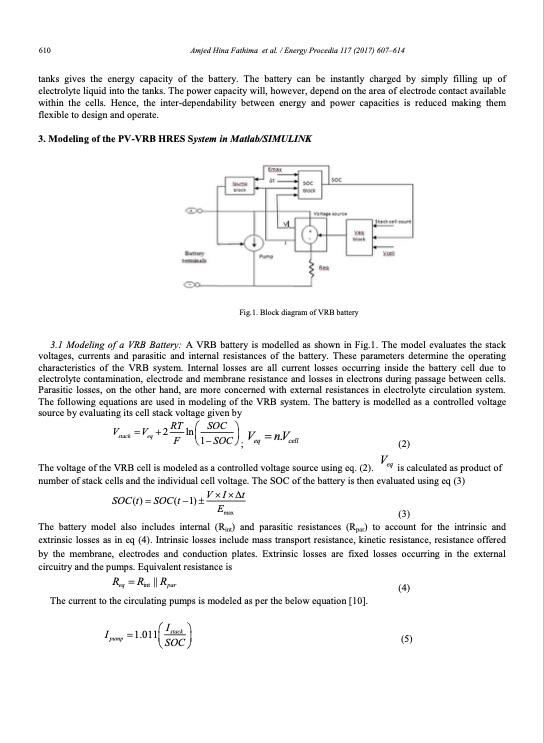
PDF Publication Title:
Text from PDF Page: 004
610 Amjed Hina Fathima et al. / Energy Procedia 117 (2017) 607–614 4 Fathima AH and Palanisamy K/ Energy Procedia 00 (2017) 000–000 tanks gives the energy capacity of the battery. The battery can be instantly charged by simply filling up of electrolyte liquid into the tanks. The power capacity will, however, depend on the area of electrode contact available within the cells. Hence, the inter-dependability between energy and power capacities is reduced making them flexible to design and operate. 3. Modeling of the PV-VRB HRES System in Matlab/SIMULINK Fig.1. Block diagram of VRB battery 3.1 Modeling of a VRB Battery: A VRB battery is modelled as shown in Fig.1. The model evaluates the stack voltages, currents and parasitic and internal resistances of the battery. These parameters determine the operating characteristics of the VRB system. Internal losses are all current losses occurring inside the battery cell due to electrolyte contamination, electrode and membrane resistance and losses in electrons during passage between cells. Parasitic losses, on the other hand, are more concerned with external resistances in electrolyte circulation system. The following equations are used in modeling of the VRB system. The battery is modelled as a controlled voltage source by evaluating its cell stack voltage given by RT SOC Vstack Veq 2 ln V n.V F 1SOC; eq cell (2) ThevoltageoftheVRBcellismodeledasacontrolledvoltagesourceusingeq.(2). Veq iscalculatedasproductof number of stack cells and the individual cell voltage. The SOC of the battery is then evaluated using eq (3) V I t SOC(t)SOC(t 1) Emax (3) The battery model also includes internal (Rint) and parasitic resistances (Rpar) to account for the intrinsic and extrinsic losses as in eq (4). Intrinsic losses include mass transport resistance, kinetic resistance, resistance offered by the membrane, electrodes and conduction plates. Extrinsic losses are fixed losses occurring in the external circuitry and the pumps. Equivalent resistance is Req Rint ||Rpar (4) The current to the circulating pumps is modeled as per the below equation [10]. I 1.011 Istack pump SOC (5)PDF Image | Operation of a Vanadium Redox Flow Battery for PV

PDF Search Title:
Operation of a Vanadium Redox Flow Battery for PVOriginal File Name Searched:
S1876610217323834-main.pdfDIY PDF Search: Google It | Yahoo | Bing
Salgenx Redox Flow Battery Technology: Salt water flow battery technology with low cost and great energy density that can be used for power storage and thermal storage. Let us de-risk your production using our license. Our aqueous flow battery is less cost than Tesla Megapack and available faster. Redox flow battery. No membrane needed like with Vanadium, or Bromine. Salgenx flow battery
| CONTACT TEL: 608-238-6001 Email: greg@salgenx.com | RSS | AMP |